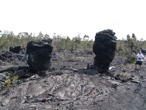1974 Lava Flow and Lava Trees
| Local Time |
Date |
Lat / Lon in Dec Degrees |
Elevation |
| 9:45:00L |
9/10/04 |
N19.4008 |
W155.25581 |
1129 m |
Our first stop was at a site of the 1974 lava flow just off
the Chain of Craters Road, adjacent to the Lua Manu Crater. Two evident spatter
ramparts show the source of the lava in this area. The distinctive features of this area are the so-called
"lava trees" standing above the surrounding flow (left picture
below). These were created when the flow erupted
from the vents and engulfed the standing ohi'a trees. The lava quickly quenched against these moist hardwoods,
leaving a chilled lava mold while the remaining hot lava continued to flow.
When lava then drained back into fissures, the surface of the flow lowered, and
the quenched molds remained elevated above their surroundings, marking the
maximum height of the flow (right picture below). The preserved molds are wider on the top, which is caused by methane gas
released from the trees and rising upward, inflating the lava. This enlargement causes the molds to be
top heavy, and many have toppled over. Paleo-flow direction can be deduced from a "seam" on
the inside of the molds, indicating the down-flow direction. Seams in one mold here indicate
paleo-flow in roughly a southerly direction. Following the event that created the created the lava
trees, another spatter eruption must have occurred, as indicated by spatter
found on top of the molds.

Lava tree molds
Marcel Croon
|

Lava tree mold with remanent of a charred tree visible
Marcel Croon
|
|